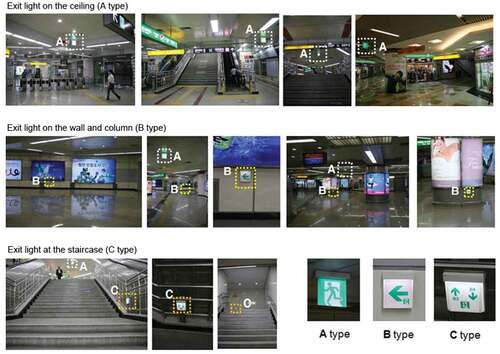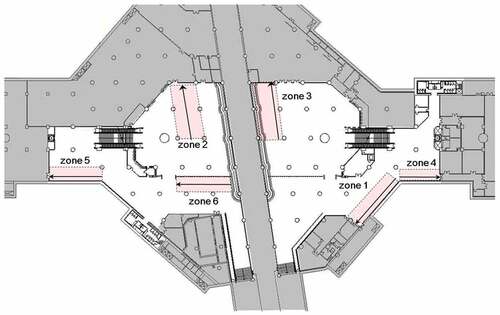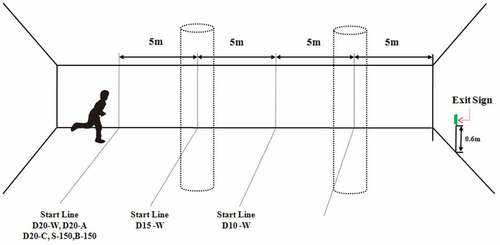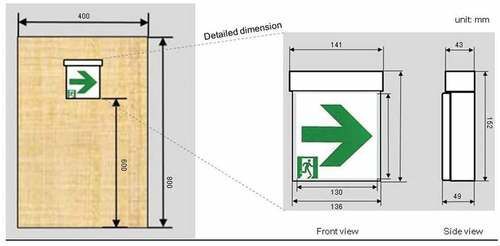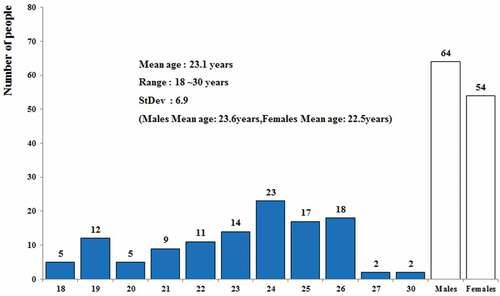ABSTRACT
Emergency exit signs have an important role in the fire safety of buildings. Exit signs help evacuees rapidly escape fire by following the fastest and safest escape routes immediately after the detection of fire. In other words, evacuation can greatly vary according to environmental factors regarding evacuation within the building. In this study, change in the evacuation speed by exit signs and environmental conditions was analyzed through experiments with 138 subjects. Four environmental factors in the experiment are visibility, distance between exit sign and evacuees, spatial configuration, and size and brightness of exit sign. In conclusion, changes in the spatial conditions around exit signs influenced the evacuation speeds of the subjects in poor visibility, and the changes in physical conditions of exit signs exerted more influence when the visibility was relatively better.
1. Introduction
One of the most important functions of a building is the safe egress of all occupants out of the building in the case of a fire event. Failure to provide safe evacuation of the building in the initial phase of fire increases the risk of mass casualties. Although the medically defined causes of fatal casualties in building fires are toxic gases and oxygen depletion, the causes are principally attributable to a failure to help the occupants escape the building in the incipient phase of fire. The determinant factors for the failure to provide for a fast and safe escape from a burning building are the panic reactions of the evacuees and the environmental inadequacy of the building. A number of fire incidents with mass casualties, such as the 2013 Daegu subway fire, vividly exemplify the importance of safe evacuation in the incipient phase of fire and the high risk of casualties as a consequence of failure to ensure fast evacuation.
The main problems leading to a failure of fire escape, as identified in previous studies of fire incidents, are smoke-induced poor visibility and irritation caused by difficulties in wayfinding (Jeon and Hong Citation2009a; Jin Citation2002). Modern buildings have various fire escape routes, which affect occupant egress during a fire. Long and complex escape routes of a building coupled with poor visibility due to smoke and flames place the building occupants at great risk of failure in self-evacuating the building. To reduce the failure rate in emergency evacuation during a fire, all buildings are equipped with emergency egress facilities complying with the fire safety requirements of the respective country. Egress facilities help evacuees rapidly escape fire by following the fastest and safest escape routes immediately after the detection of fire. Many field studies proved the importance of emergency egress facilities in ensuring fire safety of a building (Benthorn and Frantzich Citation1999; Horasan Citation1999). However, evacuation efficiency can greatly vary according to the type of egress facilities and environmental factors within the building.
This study was conducted to analyze changes in the evacuation speed induced by egress facilities and environmental conditions. Specifically, the influence of exit signs, one of the most common egress facilities, was examined. The relationship between exit signs and fire escape was analyzed with respect to the installation conditions of the exit signs. Evacuation experiments were performed to measure the evacuation speed of subjects according to variations in four environmental factors influencing the evacuation efficiency, namely, visibility, distance between exit sign and evacuees, spatial configuration, and size and brightness of exit sign.
2. Exit signs
An exit sign is a representative fixture of emergency egress facilities. Exit signs are installed to indicate the exit or escape routes and should fulfill the function of efficiently guiding evacuees out of the building during emergency evacuation events. Therefore, it is important to evaluate their effect on the movements of evacuees within the building to escape fire. Many researchers have noted that the brightness, size, and distance of exit signs influence their visibility. Jin et al. (Citation1991) and Jin and Yamada (Citation1994) elucidated smoke-induced visibility changes, and Collins, Dahir, and Madrzykowski (Citation1993) and Wong and Lo (Citation2007) noted that the shape, color, luminance contrast, directional markings, and surroundings of exit signs influence their visibility. The visibility of exit signs was assessed on the basis of the escape behavior of evacuees, who escaped fire by following the exit signs installed along pathway walls.
Standards for exit sign design and installment vary by country (NFPA 101 Citation2018;BS 5499-1 Citation2002; NFSC 303 Citation2016). A typical exit sign most commonly used in buildings consists of three parts, namely, display surface, light source, and driver circuit. Before the year 2000, most exit signs used fluorescent lamps. The prevalence of cold cathode fluorescent lamps (CCFLs) increased after they emerged as a new light source for display devices in 2000. More recently, various light sources, such as LEDs and photoluminescent materials, have been developed and applied to exit signs, and their evacuation efficiency has been studied (Na, Jeon, and Hong Citation2008; Jeon and Hong Citation2009b).
The design elements of the display surface of an exit sign are directional indicator, symbol, and word. Worldwide, green or red is commonly used for the display surface because of their high recognition value (Ouellette Citation1988; Eklund Citation1999). In South Korea, typical exit sign colors are white and green with different color combinations depending on the type of exit sign. As shown in , exit signs in exit doorways have white letters on green background, and those along pathways have the inverse color combination. The former is installed on ceilings, and the latter on walls and columns and on the floor of broad spaces.
3. Experiments
3.1. Experimental variables
As mentioned in the introduction, changes in evacuation efficiency depending on the environmental factors that are key to the evacuation procedure were experimentally analyzed. This study defined four environmental factors related to the exit sign installment and evacuation conditions: visibility, distance between exit sign and evacuees, spatial configuration, and size and brightness of exit sign.
The first factor, visibility, which changes according to the smoke density in case of fire, is the most important variable for wayfinding during an emergency egress. All experiments were performed in the condition of reduced visibility from smoke development. Considering that different degrees of visibility limit the escape ability of evacuees depending on their familiarity with the building (Nelson and Mowrer Citation2002), the visibility conditions were set in three levels (). Level 1 was the visibility limit encountered by those who were not familiar with the pathways of the building. Level 2 corresponded to the limit due to intensified smoke development and would be applicable to even those who were familiar with the building. Level 3 was total invisibility due to continuous smoke development, leading to failure of escape. The smoke conditions were simulated by controlling the visibility of evacuees with translucent eye patches with a visible light transmission percentage of < 100% according to the method used in Jeon and Hong’s (Citation2009b) experimental study.
Table 1. Condition of reduced visibility in experiments.
The distance to the exit sign was set at 10 m, 15 m, and 20 m based on the standard installation interval of pathway exit signs specified by the pertinent regulations in South Korea (NFSC 303). Spatial configuration was classified into the following three types depending on the spatial configuration of the surroundings between the departure point and exit route ():
Wall type in the case of an escape route along a wall,
Column type in the case of an escape route including columns, and
Open type in the case of an escape route across a space without walls or columns.
The size and brightness of exit signs were classified into the following three types:
Typical type: the same specifications as the commonly used pathway exit signs,
S150 type: 150% of the size of the typical type, and
B150 type: 150% of the brightness of the typical type.
The exit signs used in the experiments were the ones commonly found in the lobbies and pathways of buildings, using CCFLs as their light source. The size of the display surface (illuminating surface) of the typical type was 130 × 130 mm, and its power consumption at the average luminance was 300 cd/m2.
3.2. Experiment cases and variable combination
The 4 environmental factors of the experiment mentioned in “3.1 Experimental variables” can be used to make 81 different experimental conditions. In this study, the visibility is considered as an independent variable for all experiments, and each of the other three environmental factors excluding visibility is considered as an independent variable affecting evacuation speed with visibility parameters. As a result, a total of 16 different experiments as shown in were conducted and analyzed in this study. That is, to analyze the relation between evacuation speed with the distance to the exit sign, the parameters for the type of exit sign and the spatial configuration were fixed as typical type and wall type respectively. And the parameters for distance (10 m,15 m, 20 m) and visibility (Level 1 & 2) were set as independent variables for the evacuation speed. The corresponding experiments are TEST1 to 6. In order to analyze the change of evacuation speed according to the spatial configuration, the parameters for the exit sign and the distance to exit sign were fixed as typical type and 20 m respectively, and the parameters for spatial configuration (wall, open and column type) and visibility (levels 1 and 2) were set as independent variables for the evacuation speed. The corresponding experiments are TEST1, 2, 7, 8, 9, and 10. In order to analyze the relation between evacuation speed with to the exit sign, the parameters for the distance and spatial variables were fixed as 20 m and wall type respectively. The type of exit sign (typical, s150 and b150 type) and three different visibilities (levels 1, 2, and 3) were set as independent variables for the evacuation speed. The corresponding experiments are TEST11 to 16.
Table 2. Conditions for evacuation experiments.
3.3. Experimental location and method
A zone evacuation method in which subjects are assigned to predetermined zones was adopted as the method for the evacuation experiments. A commercial complex underground subway station was chosen as the experimental site because it afforded convenience regarding environmental settings due to easy visibility control with eye patches and various spatial constellations. The experimental site was a four-story structure, and the experiments were conducted on the third underground floor with the largest area. As shown in , six zones were used for the evacuation experiment.
As illustrated in , the evacuation performance for each zone was tested by the movement of the subjects from the start line to the finish line with an exit sign over it. Both the start and finish lines were straight lines, and one subject was assigned to the start line of each zone. The reaction time between the alarm and escape onset was recorded, and the time taken to reach the finish line was recorded at 5 m intervals. The exit sign of the finish line was installed at 0.6 m height on a 0.4 m (w) × 0.8 m (h) wooden board, as shown in .
The evacuation speeds and changes in the speed of individual subjects according to the experimental conditions were compared, and the relationships between the environmental factors and individual evacuation performance were analyzed using a one-way analysis of variance (ANOVA). In the case of distance to exit sign, an independent two-sample t-test was employed, instead of the one-way ANOVA, considering the heterogeneity among the subjects.
As subjects, 138 citizens without experience or knowledge of the experimental site were recruited. As outlined in , the percentage of males was slightly higher (52.9%). The average age was 23 years, and the average height 169.6 cm.
4. Results and discussion
4.1. Distance to exit sign
The effect of distance to exit sign was analyzed from the results of six experiments, where the typical-type exit signs were used in a wall-type space with three distances and level 1 and 2 visibilities (W-10-TYP-1, W-15-TYP-1, W-20-TYP-1, W-10-TYP-2, W-15-TYP-2, and W-20-TYP-2; ). In all experimental conditions, although the highest speed was observed in the section between 5 m and 10 m, reduced distances from the starting point to the exit sign did not increase the evacuation speed. The highest evacuation speed was observed in the D20W evacuees having the longest interval. As shown in , in level 1 visibility, the subjects assigned to W-20-TYP-1 moved most rapidly and the subjects assigned to W-10-TYP-1 moved most slowly. In level 2 visibility, the subjects assigned to W-20-TYP-2 moved most rapidly and the subjects assigned to W-15-TYP-2 moved most slowly. In Jeon and Hong’s (Citation2009b) experiment as well, an increase in the installment interval relative to stride length influenced the length of paths taken by the evacuees, but not their evacuation speed. In this experiment, however, the D10W evacuees having the shortest distance to the exit sign were least affected by the decrease in the evacuation speed induced by the visibility lowered from level 1 to level 2.
Table 3. Distance to exit sign and evacuation speed.
As shown in , in the visibility condition of level 1 (W-10-TYP-1 and W-20-TYP-1), evacuees showed a statistically significant difference in the evacuation speed. This result implies that the difference in the distance to exit sign should be at least 10 m to induce a statistically significant difference in the speed of evacuees. However, in level 2 visibility with relatively more intense visual limitations, a significant difference in the evacuation speed was observed between the conditions with a 5 m difference (between W-15-TYP-2 and W-20-TYP-2).
Table 4. Distance to exit sign and differences in average speed (Independent samples T-testa).
4.2. Spatial configuration
The effect of spatial configuration on the evacuation speed was examined on the basis of the results from 6 experiments performed in 3 different experimental zones at 20 m distance from the starting point to the exit and level 1 and 2 visibilities (W-20-TYP-1, W-20-TYP-2, O-20-TYP-1, O-20-TYP-2, C-20-TYP-1, and C-20-TYP-2; ). As shown in , the D20C subjects moved most rapidly. Although movement posture of subjects was partly different among the spatial conditions as shown in , differences in the spatial configuration did not elicit any statistically significant differences in evacuation speeds in level 1 (F = 0.363, df = 2, p > 0.05) and level 2 (F = 1.737, df = 2, p > 0.05) visibilities ().
Table 5. Spatial configuration and evacuation speed.
Table 6. Difference in average evacuation speed depending on spatial configuration.
Likewise, spatial conditions and evacuation speeds were not significantly correlated in level 1 visibility. However, in level 2 visibility with relatively more intense visual limitations, spatial conditions influenced the evacuation speed to a greater extent (eta^2 = 0.039 in level 1, eta^2 = 0.155 in level 2; ). Similar to the results presented in Section 4.1, the highest section-dependent evacuation speed was exhibited in the section between 5 m and 10 m, except in the case C-20-TYP-2.
4.3. Specifications of exit sign
The effect of size and brightness of the exit sign was analyzed from the results of six experiments that employed values that were 1.5 times the size and brightness of the typical-type exit signs, along with a distance to exit sign of 20 m, wall-type zone, and level 1, 2, and 3 visibilities (W-20-S150-1, W-20-S150-2, W-20-S150-3, W-20-B150-1, W-20-B150-2, and W-20-B150-3; ). As shown in , the subjects moved faster when the size of the exit sign was increased (S150) than when the brightness was increased (B150). The difference in the evacuation speed was greatest in level 1 visibility, with the difference decreasing as the visibility deteriorated, as shown in . The speed difference between the S150 and B150 conditions was found to have statistical significance only in level 1 visibility (F = 5.430, df = 1, p < 0.05). Although the correlation between spatial configuration and evacuation speed was higher as the visibility was lowered, the highest correlation between the exit sign specification and the evacuation speed was shown in level 1 visibility with the highest visibility (eta^2 = 0.312).
Table 7. Evacuation speed depending on specification of exit signs.
5. Conclusion
This study aimed to determine the correlation between exit signs and evacuation efficiency with respect to exit sign installation and environmental factors related to emergency egress. A total of 16 evacuation experiments were performed by varying the visibility, distance to exit sign, spatial configuration, and size and brightness of exit sign. Data of 138 subjects were analyzed, and the results can be summarized as follows.
The distance to exit sign and the spatial configuration exerted no significant influence on the evacuation speeds of the subjects. Whereas a reduced distance from the starting point to the exit sign could not change the evacuation speeds significantly in a given visibility condition, the subjects moved most rapidly in the section between 5 m and 10 m. With lowered visibility, the subjects significantly slowed down. A decrease in speed due to lowered visibility was smallest at the shortest distance to exit signs. The average evacuation speed improved to a greater degree when the size of exit sign was increased than when the brightness was increased. Such difference was exhibited most markedly in level 1 visibility with relatively longer visible distance, contrary to the results of speed differences in other conditions. In other words, changes in the spatial conditions around exit sign influenced the evacuation speeds of the subjects in poor visibility, and the changes in physical conditions of exit sign exerted more influence when the visibility was relatively better.
However, because the results of this experimental study were derived from subjects with an average age of 23 years (18–30 years), change characteristics for evacuation speed may differ depending on the age range of the people, as in other studies by Jeon et al. (Citation2014). Another limitation of this study is with regard to the combination of experimental variables. As mentioned in Section 3.2, in this study, 16 experiments were conducted by controlling the independent variables. Considering all the combinations of variables related to the environmental factor in this study, more various relations might be addressed.
Acknowledgments
This research was supported by the Architecture & Urban Research Program funded by Ministry of Land, Infrastructure and Transport of Korean government (Grant Number: 16AUDP-B100356-02), and by the 2019 Scientific Program funded by Jeju National University, and also by the National Research Foundation of Korea (NRF) grant funded by the Korea government(NRF-2018R1A6A3A01012605).
Disclosure statement
No potential conflict of interest was reported by the authors.
Additional information
Funding
Notes on contributors
Gyu-Yeob Jeon
Gyu-Yeob Jeon is an associate professor at Jeju National University.
Wook-Jeong Na
Wook-Jeong Nais a visiting professor at Kyungpook National University.
Won-Hwa Hong
Won-Hwa Hong is a professor at Kyungpook National University.
Jin-Kook Lee
Jin-Kook Lee is an assistant Professor at Yonsei University.
References
- Benthorn, L., and H. Frantzich. 1999. “Fire Alarm in a Public Building: How Do People Evaluate Information and Choose and Evacuation Exit.” Fire and Materials 23 (6): 311–315. doi:10.1002/(SICI)1099-1018(199911/12)23:6<311::AID-FAM704>3.0.CO;2-J.
- BS 5499–1. 2002. Safety Signs, including Fire Safety Signs. Part 1: Specification for Geometric Shapes, Colours and Layouts. London: British Standards Institution.
- Collins, B. L., M. S. Dahir, and D. Madrzykowski. 1993. “Visibility of Exit Signs in Clear and Smoky Conditions.” Fire Technology 29 (2): 154–182. doi:10.1007/BF01038537.
- Eklund, N. H. 1999. “Exit Sign Recognition for Color Normal and Color Deficient Observers.” Journal of the Illuminating Engineering Society 28 (4): 71–81. doi:10.1080/00994480.1999.10748254.
- Horasan, M. B. N. 1999. “Occupant Evaluation and Orientation Problems in Large Hall: An Exhibition Building Case Study.” Fire and Materials 23 (6): 369–373. doi:10.1002/(SICI)1099-1018(199911/12)23:6<369::AID-FAM713>3.0.CO;2-T.
- Jeon, G. Y., J. H. Choi, W. H. Hong, and J. H. Kim. 2014. “Study on the Relation between Age and Evacuation in case of Underground Evacuation.” Contemporary Engineering Science 7 (21): 1045–1052. doi:10.12988/ces.2014.49131.
- Jeon, G. Y., and W. H. Hong. 2009a. “Characteristic Features of the Behavior and Perception of Evacuees from the Daegu Subway Fire and Safety Measures in an Underground Fire.” Journal of Asian Architecture and Building Engineering 8 (2): 415–423. doi:10.3130/jaabe.8.415.
- Jeon, G. Y., and W. H. Hong. 2009b. “An Experimental Study on How Phosphorescent Guidance Equipment Influences on Evacuation in Handicapped Visibility.” Journal of Loss Prevention in the Process Industries 22: 934–942. doi:10.1016/j.jlp.2009.08.008.
- Jin, T. 2002. “Visibility and Human Behavior in Fire Smoke.” In SFPE Handbook of Fire Protection Engineering, 2-42. 3rd. Quincy, MA: National Fire Protection Association.
- Jin, T., and T. Yamada. 1994. “Experimental Study on Effect of Escape Guidance in Fire Smoke by Travelling of Light Source.” Proceedings of the Fourth International Symposium of Fire Safety Science, 705–714. Ottawa, Canada.
- Jin, T., T. Yamada, S. Kawai, and S. Takahashi. 1991. “Evaluation of the Conspicuousness of Emergency Exit Signs.” Proceedings of the Third International Symposium of Fire Safety Science, 835–841. Edinburgh, Scotland, United Kingdom.
- Ministry of Public Administration and Security. 2016. NFSC (National Fire Safety Code) 303: Fire Safety Regulation of Exit Light and Exit Sign. Seoul: Ministry of Public Administration and Security.
- Na, W. J., G. Y. Jeon, and W. H. Hong. 2008. “A Study on the Evacuation Performance in case LED-sign Is Installed in the Building according to Full Scale Test.” Journal of the Architectural Institute of Korea Planning & Design 24 (8): 251–259.
- Nelson, H. E., and F. W. Mowrer. 2002. “Emergency Movement.” In SFPE Handbook of Fire Protection Engineering, 3-367. 3rd. Quincy, MA: National Fire Protection Association.
- NFPA (National Fire Protection Association). 2018. "Means of Egress". In NFPA 101: Life Safety Code. MA: National Fire Protection Association.
- Ouellette, M. J. 1988. “Exit Signs in Smoke: Design Parameters for Greater Visibility.” Lighting Research and Technology 20 (4): 155–160. doi:10.1177/096032718802000402.
- Wong, L. T., and K. C. Lo. 2007. “Experimental Study on Visibility of Exit Signs in Buildings.” Building and Environment 42: 1836–1842. doi:10.1016/j.buildenv.2006.02.011.

